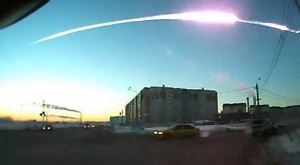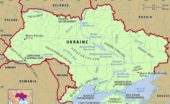Re Ian Bremmer 'Could third-party candidates upend the 2024 US election?' 3 April The current political movement in the USA…
Space: the final frontier 2009 – 15
Written by Diana Thebaud Nicholson // July 23, 2015 // Aviation & Aerospace, Science & Technology // Comments Off on Space: the final frontier 2009 – 15
See also NASA
Mars ; space.com
23 July
NASA’s Kepler Mission Discovers Bigger, Older Cousin to Earth
NASA’s Kepler mission has confirmed the first near-Earth-size planet in the “habitable zone” around a sun-like star. This discovery and the introduction of 11 other new small habitable zone candidate planets mark another milestone in the journey to finding another “Earth.”
The newly discovered Kepler-452b is the smallest planet to date discovered orbiting in the habitable zone — the area around a star where liquid water could pool on the surface of an orbiting planet — of a G2-type star, like our sun. The confirmation of Kepler-452b brings the total number of confirmed planets to 1,030.
“On the 20th anniversary year of the discovery that proved other suns host planets, the Kepler exoplanet explorer has discovered a planet and star which most closely resemble the Earth and our Sun,” said John Grunsfeld, associate administrator of NASA’s Science Mission Directorate at the agency’s headquarters in Washington. “This exciting result brings us one step closer to finding an Earth 2.0.”
Kepler-452b is 60 percent larger in diameter than Earth and is considered a super-Earth-size planet. While its mass and composition are not yet determined, previous research suggests that planets the size of Kepler-452b have a good chance of being rocky.
While Kepler-452b is larger than Earth, its 385-day orbit is only 5 percent longer. The planet is 5 percent farther from its parent star Kepler-452 than Earth is from the Sun. Kepler-452 is 6 billion years old, 1.5 billion years older than our sun, has the same temperature, and is 20 percent brighter and has a diameter 10 percent larger.
“We can think of Kepler-452b as an older, bigger cousin to Earth, providing an opportunity to understand and reflect upon Earth’s evolving environment,” said Jon Jenkins, Kepler data analysis lead at NASA’s Ames Research Center in Moffett Field, California, who led the team that discovered Kepler-452b. “It’s awe-inspiring to consider that this planet has spent 6 billion years in the habitable zone of its star; longer than Earth. That’s substantial opportunity for life to arise, should all the necessary ingredients and conditions for life exist on this planet.”
14 July
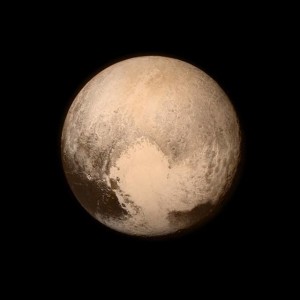 Pluto flyby photos thrill New Horizons scientists after nine-year Nasa mission
Pluto flyby photos thrill New Horizons scientists after nine-year Nasa mission
(The Guardian) Nasa spacecraft makes history as the first spacecraft to reach distant dwarf planet, the last unexplored world in solar system
The moment, played out on Tuesday to the sound of The Final Countdown by the 1980s glam metal band Europe, marked a historic achievement for the US, which can now claim to be the only nation to have visited every planet in the classical solar system.
When New Horizons left, Pluto was still a planet—the story of the most controversial body in the solar system
(Quartz) The NASA mission exploring the Kuiper Belt—the remote corner of the solar system hosting, amongst others, Pluto and its moons—has beamed home an image of the dwarf planet taken at the closest range yet, about 7,750 miles from the surface of Pluto (or, as NASA itself said, from a distance similar that between Mumbai and New York City). A spacecraft known as New Horizons traveled for more than nine years and 3 billion miles to get the shot. This is the farthest out humankind has reached in the universe; it is spellbinding.
The search for “Planet X,” as it was originally called (it was later renamed Pluto at the suggestion of an 11-year-old girl with a passion for Greek mythology), had been ongoing since the early 1900s. Faint traces of what can be now recognized as Pluto appeared in several images from 1909 to 1915. But the official discovery of the planet Pluto wouldn’t be announced until 1930, by a 24-year-old American astronomer named Clyde Tombaugh (pdf). He died in 1997; a portion of his ashes were placed onboard New Horizons for its trip to Pluto.
Pluto was initially believed to have a mass similar to the Earth’s—arguing for its planethood—but subsequent studies revised it to a tiny fraction of that, from 0.1, 0.01, 0.002, and finally 0.00218 the size of the Earth. The downsizing carried with it doubts as to whether the celestial body was or was not an actual planet. On Sept. 13, 2006, a few months after the New Horizons mission started, Pluto was downgraded to a dwarf planet.
Pluto flyby confirmed by NASA — CBC’s Bob McDonald on the successful flyby of NASA’s New Horizons spacecraft
Pluto: 6 facts you should know about the dwarf planet
A Pluto year is about 248 Earth years
10 July
Philae phones home for the eighth time
Europe’s robot lab Philae, zipping towards the Sun on a comet, has called home for the eighth time since waking up from hibernation last month, French space agency CNES said Friday.
After a 15-day silence, Philae had a 20-minute conversation with ground control via its mother ship Rosetta, in orbit around comet 67P/Churyumov-Gerasimenko, it said in a statement.
This was “very encouraging news for the remainder of the Philae mission,” the agency said.
There had been no news from the washing machine-sized robot lab since June 24, a disquieting break for mission controllers.
Philae first woke up on June 13 after seven months in hibernation on the comet’s surface.
2014
15 November
Rosetta comet mission: No communication from Philae lander
Philae landed next to cliff that largely blocked sunlight from reaching its solar panels
(CBC) The pioneering lander Philae completed its primary mission of exploring the comet’s surface and returned plenty of data before depleted batteries forced it to go silent, the European Space Agency said Saturday.
“All of our instruments could be operated and now it’s time to see what we got,” ESA’s blog quoted lander manager Stephan Ulamec as saying.
Since landing Wednesday on comet 67P/Churyumov-Gerasimenko some 500 million kilometres away, the lander has performed a series of scientific tests and sent reams of data, including photos, back to Earth.
14 November
The end is nigh for Philae comet lander, but team mulls last-minute rescue
(Science) All things come to an end, and with the Philae comet lander, it appears to be coming all too soon. On Thursday, mission leaders had been extremely cautious—wary of using moving parts for fear of upsetting the precarious position of the three-legged robot, which is wedged in and tipped up on its side, in the shadow of a wall of material. But by Friday morning, that precaution had given way to a headlong rush for the European Space Agency (ESA), which just 2 days earlier was celebrating the historic success of the Rosetta mission. Scientists were trying to gather data from all 11 lander instruments before the 60-hour battery expired. The wan 1.5 hours per day of light that strikes the solar panels is not enough to recharge its batteries in a significant way.
So overnight, an x-ray instrument was lowered to the comet, and a hollow rod meant to measure thermal and mechanical properties was hammered into the surface. On Friday morning, the team was uploading commands to drill into the subsurface, in order to feed a sample to two evolved gas experiments—the most complicated and energy-intensive experiments on the lander. During a radio pass planned for Friday night—probably one of the last exchanges of the mission—there was talk of rotating the solar panels into a more favorable position, or even doing something more radical, like hopping with the lander’s springy legs and hoping for the best. “We are coming now to the end so we are taking more and more risks,” says Paolo Ferri, the head of mission operations at ESA’s command center here.
12 November
Rosetta Probe Makes Historic Comet Rendezvous
The space probe Rosetta on Wednesday made a historic rendezvous with a comet, climaxing a 10-year, 3.7-billion-mile chase through the Solar System, the European Space Agency (ESA) said.
 “We’re at the comet,” Rosetta’s flight operations manager, Sylvain Lodiot, declared in a webcast from mission control in Darmstadt, Germany.
“We’re at the comet,” Rosetta’s flight operations manager, Sylvain Lodiot, declared in a webcast from mission control in Darmstadt, Germany.
It marks the first time a spacecraft has been sent into orbit around a comet, a wanderer of the Solar System whose primeval dust and ice may hold insights into how the planets formed.
Philae probe makes historic landing on comet
Rosetta mission’s safe landing gives scientists their first chance to ride a comet and study close up what happens as it gets closer to the sun
The signal broke a seven-hour wait of agonising intensity and sparked scenes of jubilation at the European Space Agency’s mission control in Darmstadt. The team in charge of the Rosetta mission achieved what at times seemed an impossible task by landing a robotic spacecraft on a comet for the first time in history.
The moment the tension broke came shortly after 1600 GMT when the Philae called home. “We are there. We are sitting on the surface. Philae is talking to us,” said a jubilant Stephan Ulamec, Philae lander manager at the DLR German space centre. “We are on the comet.”
But celebrations were tempered by the later discovery that the probe’s two harpoons had not fired to fasten the craft down in the ultra-low gravity. Scientists now think the probe may have bounced after first coming into contact with the surface. Ulamec said: “Maybe today we didn’t just land once, we landed twice.”
The safe, if precarious, touchdown of the lander gives scientists a unique chance to ride onboard a comet and study from the surface what happens as its activity ramps up as it gets closer to the sun. The first images beamed back from the lander’s descent revealed a dramatic landscape of pits and precipices, craters and boulders. However, there have been gaps in its radio link with the orbiting Rosetta mothership.
6 August
Spacecraft Rosetta catches up to comet after 10-year chase
(Reuters) – European spacecraft Rosetta became the first ever to catch up with a comet on Wednesday, a landmark stage in a decade-long space mission that scientists hope will help unlock some of the secrets of the solar system.
Rosetta, launched by the European Space Agency (ESA) in 2004, will accompany comet 67P/Churyumov-Gerasimenko on its trip around the sun and land a probe on it later this year in an unprecedented maneuver.
Scientists are now on a tight schedule to learn enough about the comet using data from Rosetta to safely land the spacecraft’s probe on it in November. … [They] hope data the probe gathers on the surface of the comet will allow them to peek into a kind of astronomical time capsule that has preserved for millions of years clues about what the world looked like when our solar system was born.
13 May
Russia Targets Space Station Project In Retaliation For U.S. Sanctions
(Reuters) – Russia cast doubt on the long-term future of the International Space Station, a showcase of post-Cold War cooperation, as it retaliated on Tuesday against U.S. sanctions over Ukraine.
Deputy Prime Minister Dmitry Rogozin said Moscow would reject a U.S. request to prolong the orbiting station’s use beyond 2020. It will also bar Washington from using Russian-made rocket engines to launch military satellites.
8 January
Obama agrees to 4-year extension for International Space Station
(Reuters) – The Obama administration wants to keep the International Space Station, a $100 billion orbital research outpost that is a project of 15 nations, flying until at least 2024, four years beyond a previous target, NASA said on Wednesday.
The extension will give the U.S. space agency more time to develop the technologies needed for eventual human missions to Mars, the long-term goal of NASA’s human space program.
Keeping the station in orbit beyond 2020 also opens a window for commercial companies and researchers to benefit from hefty U.S. investment in the outpost.
2013
18 June
Cause Of Yuri Gagarin Death Finally Revealed By Fellow Cosmonaut
For more than 45 years, the death of Russian cosmonaut Yuri Gagarin, the first human to cross the Earth´s threshold and venture into space, has been shrouded in secrecy. But now, details of his 1968 death have been released by none other than the first man to walk in space, Aleksey Leonov.
Gagarin, who became the first man to travel into space on April 12, 1961, was killed when his MiG-15 aircraft crashed on March 27, 1968. Gagarin was just 34 years old. The details of that crash and his death have long been a confusing and controversial subject, with many theories coming forward on the actual cause of his death.
Now, Leonov, who conducted the first ever extra-vehicular spacewalk in 1965, has delved deeper into the touchy subject of the Gagarin death mystery. Leonov has been fighting for 20 years or more to gain permission to disclose the details of what happened that tragic day in 1968.
14 June
Top space agency post pick sparks militarization concerns
Retired general Walt Natynczyk will take over the CSA in August
(CBC) Space-industry representatives are generally welcoming the appointment of retired general Walt Natynczyk as the new president of the Canadian Space Agency.
But there’s some concern the appointment of a former Canadian Forces boss might signal an impending militarization of the country’s space program.
13 May
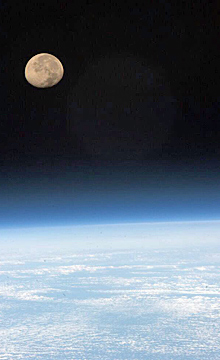 Chris Hadfield returns from space Great coverage from CBC with Marc Garneau’s commentary
Chris Hadfield returns from space Great coverage from CBC with Marc Garneau’s commentary
Astronaut Chris Hadfield, the first Canadian to command the International Space Station, has begun the return voyage to Earth after almost five months in orbit.
Aboard a Soyuz capsule, Hadfield, along with flight engineers American Tom Marshburn and Russian Roman Romanenko, undocked from the space station at 7:08 p.m. ET to begin their journey home.
How Chris Hadfield turned earthlings on to space
(CBC) for Hadfield and the Canadian Space Agency there is hope that the unique way the charismatic 53-year-old was able to connect with people on Earth will be more than a curiosity that lingers on through the tweets, videos and pictures, which showed him doing everything from playing his guitar to testing his blood.
Instead, they hope, the interest that Hadfield has roused over the past five months will help forge a stronger role for Canada in space at a time when that future is anything but certain.
A look at Chris Hadfield, the Canadian who made space cool
(Global) Since blasting off from Kazakhstan on December 19, 2012, Hadfield has become an international sensation, making space accessible to millions around the world. His photos of Earth from space set the Twitterverse afire. He has over 869,000 followers on Twitter. And now, the first Canadian commander of the International Space Station is heading home.
Hadfield mission highlights (video) Astronaut connects with Canadians from space
10 April
NASA-backed fusion engine could cut Mars trip down to 30 days
“Using existing rocket fuels, it’s nearly impossible for humans to explore much beyond Earth,” said lead researcher John Slough, a UW research associate professor of aeronautics and astronautics in a statement. “We are hoping to give us a much more powerful source of energy in space that could eventually lead to making interplanetary travel commonplace.”
The proposed Fusion Driven Rocket (FDR) is a 150-ton system that uses magnetism to compress lithium or aluminum metal bands around a deuterium-tritium fuel pellet to initiate fusion. The resultant microsecond reaction forces the propellant mass out at 30 kilometers per second, and would be able to pulse every minute or so and not cause g-force damage to the spacecraft’s occupants.
The spent fuel pellet is ejected behind the motor to provide propulsion, and because the whole process is magnetically controlled there’s relatively little wear and tear on the engines. A pellet the size of a grain of sand would provide the same propellant as a gallon of conventional rocket fuel.
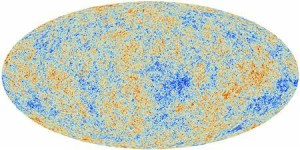
An image of the anisotropies of the Cosmic microwave background (CMB) as observed by Planck is seen in this handout released March 21, 2013 by the European Space Agency. REUTERS/ESA-Planck Collaboration/Handout
21 March
Universe is older than previously thought, new study shows
(Reuters) – Closer scrutiny of radiation left over from the creation of the universe shows the Big Bang took place about 13.8 billion years ago, 100 million years earlier than previous estimates, scientists said on Thursday.
Astronomers map universe’s beginning with space telescope ‘time machine’
A space telescope that spent over a year mapping the birth of the universe has revealed the cosmos is older than originally thought, but began with a single ‘Big Bang’ explosion that caused the universe to burst from subatomic size to a sprawling expanse in less than a second.
The European Space Agency’s US$900 million Planck space telescope, launched in 2009, spent more than 15 months mapping the ancient light still radiating from the Big Bang, with the help of NASA scientists.
Voyager 1 space probe reaches outer fringe of solar system
(Reuters) – Voyager 1, launched in 1977 to explore the outer planets, has passed into a new region on its way out of the solar system, scientists said on Wednesday.
The spacecraft, now more than 11 billion miles (18 billion km) away, detected two distinct and related changes in its environment on August 25, 2012, scientists write in paper to be published in Geophysical Research Letters and emailed to Reuters on Wednesday.
The probe detected dramatic changes in the levels of two types of radiation, one that stays inside the solar system, the other which comes from interstellar space.
Voyager Solar System ‘exit’ debated
(BBC) The possibility that the Voyager-1 spacecraft may have left the Solar System is being hotly debated.
Launched in September 1977, the probe was sent initially to study the outer planets, but then just kept on going.
Researchers studying its data say the craft appears now to be in a realm of space beyond the influence of our Sun.
But the US space agency (Nasa), which manages Voyager, says that it regards the probe as still being inside the Solar System.
14 March
Europe, Russia to launch Mars mission to sample soil for signs of life
(Reuters) – Europe and Russia signed a deal on Thursday for a joint Mars mission which will bore beneath the Red Planet’s surface for soil samples they hope will solve the mystery of whether there is life beyond Earth.
21 February
NASA Releases Stunning Video of ‘Fiery Looping Rain on the Sun’
(The Atlantic) The bubbling tumult of the sun’s surface regularly produces some pretty jaw-dropping sights, but it’s rare that we get to see something like this — and in motion to boot.
Last summer, an eruption on the sun’s surface scored a solar weather hat trick, racking up all three of the major phenomenon scientists observe: a solar flare, a coronal mass ejection (CME), and coronal rain, “complex moving structures in association with changes in magnetic field lines that loop up into the sun’s atmosphere,” NASA explains.
18 February
Russian meteor strike that injured 1,200 people was US weapons test, claims politician
(The Independent) According to Zhirinovsky, who is perhaps more famous for fist-fights than physics, meteorites falling on Russia is an impossibility.
Referring to outer space Zhirinovsky said: “Nothing will ever fall out there, if something falls, it’s people doing that. People are the instigators of wars, the provocateurs.”
15 February
On the same day as a meteor hit Russia, an asteroid careened towards Earth. Jeffrey Brown talks to astrophysicist Neil deGrasse Tyson about this cosmic coincidence, how the meteor and asteroid came so close to Earth, what risks it poses and why this is a ‘wake-up call.’ (PBS Newshour Cosmic coincidence)
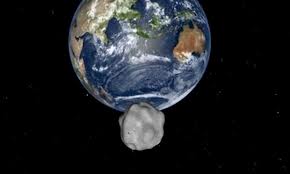 Asteroid 2012 DA14 in record-breaking Earth pass
Asteroid 2012 DA14 in record-breaking Earth pass
An asteroid as large as an Olympic swimming pool has raced past the Earth at a distance of just 27,700km (17,200mi) – the closest ever predicted for an object of that size.
It passed far closer even than the geosynchronous satellites that orbit the Earth, but there was no risk of impacts or collisions.
Incoming asteroid will miss Earth, unrelated to meteor over Russia
(Globe & Mail) An asteroid hurtled toward Earth’s backyard, destined Friday to make the closest known flyby for a rock of its 45-meter size. In a startling coincidence, a meteor exploded above Russia’s Ural Mountains just hours before the asteroid was due to zoom past the planet.
Meteorite explodes over Russia, more than 1,000 injured
(Reuters) – A meteorite streaked across the sky and exploded over central Russia on Friday, raining fireballs over a vast area and causing a shock wave that smashed windows, damaged buildings and injured 1,200 people.
Asteroid impacts — How to avert Armageddon
(The Economist) WORRYING about the threats posed by space rocks has traditionally been the preserve of the paranoid. No one doubts that asteroids have hit Earth in the past, with nasty consequences, but because the chances of any such event happening in a given year are so low, most people have been content to ignore the risk.
Today, however, a meteor was seen streaking through the sky above Yekaterinberg in Russia. It hit the ground (possibly landing in a lake) near another city, Chelyablinsk. It is thought to be the biggest meteor to hit Earth in more than a century. … Also today, a 50 metre-wide asteroid called 2012 DA14 is zipping past Earth inside the orbit of some man-made satellites, marking the closest shave on record for an asteroid of that size. This pair of unrelated events ought to focus minds, and not just among the small group of astronomers who have been worrying about asteroid strikes for many years.
10 February
Beware of Errant Asteroids
(NYT) While no known asteroids or comets represent a worrisome impact threat now, NASA’s Jet Propulsion Laboratory shows more than two dozen asteroids have better than a one in a million chance of smacking into Earth within the next 100 years. That may sound reassuring, but we estimate that less than 10 percent of all near-Earth objects have been discovered. And while we are keeping a vigilant eye out for these objects in the Northern Hemisphere, we are considerably less watchful in the Southern Hemisphere.
It has been only within the last 15 years that astronomers, mostly supported by NASA, have begun discovering the vast number of near-Earth objects. Our findings have led us to the realization that Earth runs its course around the sun in a cosmic shooting gallery — with us as the target. Basketball-size rocky objects enter Earth’s atmosphere daily and Volkswagen-size objects every few months, but they burn up before they hit the ground.
Objects larger than about 100 feet in diameter, the size of a large house, strike Earth with an average interval of a few hundred years. The last one of about this size to hit was on June 30, 1908, in a sparsely populated region of Siberia called Tunguska. The Tunguska blast released about four megatons of energy and leveled millions of trees across 825 square miles.
7 February
Captain Kirk calls Chris Hadfield at space station
Canadian astronaut likens video to a ‘real-life Star Trek episode’
(CBC) Canadian actor William Shatner, best known as Star Trek’s Captain Kirk, hailed the International Space Station and chatted with Canadian astronaut Chris Hadfield this morning about the risks faced in space and rumours that Hadfield has volunteered to go to Mars.
Over the casual, 10-minute conversation, Shatner asked Hadfield about the dangers of going into space, especially to a place such as Mars.
Hadfield, whose side of the conversation was broadcast over a video link, responded that people like him are inspired to take such risks by both the astronauts that have come before him and fictional ones such as Star Trek’s Captain Kirk.
18 January
Greg Weston: Canada’s space agency spirals towards Code Red
CSA battered by funding cuts, criticism from government, and loss of leader
(CBC) Over the past year, the Canadian Space Agency has been battered by government budget cuts, buffeted by a critical review, and now even its president is ejecting right out of the place.
This week, the federal agency announced former Canadian astronaut Steve MacLean is suddenly leaving the helm at the end of this month to pursue a new career in quantum physics.
7 January
NASA’s Kepler telescope snaps evidence of 100 billion planets in our galaxy
Over 100 billion planets likely exist in our galaxy, according to a new studyby astronomers using the Kepler Space telescope.
“There’s at least 100 billion planets in the galaxy — just our galaxy,” said John Johnson, a professor of astronomy at the California Institute of Technology, according to Science Daily. “That’s mind-boggling.”
“It’s a staggering number, if you think about it,” adds Jonathan Swift, who was the lead author of the new research paper. “Basically there’s one of these planets per star.”
Astronomers have been studying a common M-class dwarf star, named Kepler-32, since the Kepler telescope was launched into orbit, four years ago, and they found that there were five planets orbiting around it. The planets were discovered by recording the brightness of the star and watching for ‘transits’ — dips in the brightness of the star caused by an orbiting planet passing between the star and us. By examining these transits carefully, astronomers can tell the mass of the orbiting planet and how quickly it orbits the star.
2012
21 December
International crew of three reaches orbiting space station
(Reuters) – A Russian Soyuz capsule carrying a multinational crew of three arrived at the International Space Station on Friday, setting the stage for a Canadian for the first time to take command of the orbital research base.
The spacecraft carrying Chris Hadfield from the Canadian Space Agency, NASA’s Tom Marshburn and Russian cosmonaut Roman Romanenko blasted off from Kazakhstan’s Baikonur Cosmodrome on Wednesday and parked at the station’s Rassvet docking module at 9:09 a.m. EST as the ships sailed 255 miles above northern Kazakhstan.
19 december 2012
Chris Hadfield, next Commander of the International Space Station
(RCI) Chris Hadfield blasted off into space at 6:12 am local time in Baikonur, Kazahkstan. Outside it was -30 C. inside the Soyuz spacecraft, the next Commander of the International Space Station was accompanied by American Tom Marshburn and Russian Roman Romanenko. They are buckled in for the two-day trip to their home for the next 147 days, 370 kilometers above the earth.
11 December
Bizarre Weather Around the Solar System
Hurricanes, tornadoes, and sulfuric-acid rain.
(Slate) Bizarre weather is not restricted to Earth. Hurricane Sandy was a speck of dust compared to some of the cataclysms currently taking place around the solar system. Jupiter, for example, is going through a tumultuous time right now. The gas giant has suffered more meteor impacts in the past four years than has ever been observed, and large cloud formations are spontaneously changing color or disappearing as quickly as they form.
But Jupiter is not the only planet in our solar system that experiences bizarre weather. Icy methane rainstorms, planet-wide sand storms, and lead-melting temperatures afflict other planets and their moons. Check out the weather forecast around the solar system, then go enjoy the weather outside—whatever it may be, it’s bound to be better than any of the following.
2 October
Public can celebrate delivery of last space shuttle — Atlantis
(NBC) On Nov. 2, space shuttle Atlantis will be transported from NASA’s Kennedy Space Center in Cape Canaveral, Fla., to the nearby visitor center. The 10-mile (16 kilometer) road trip will take about 11 hours, including a three-hour stop to give the public a chance to walk around the spacecraft.
When it opens in July 2013, the Atlantis exhibit at NASA’s Kennedy Space Center Visitor Complex will showcase the shuttle and its 30-year history. Guests will see Atlantis as it looked during its 33 spaceflights, its payload bay doors open and (replica) robotic arm extended. Surrounding the shuttle will be more than 60 exhibits spanning two floors, including a full-size replica of the Hubble Space Telescope.
Next month’s move will mark the last stop for Atlantis, and NASA’s final time overseeing the transport of a shuttle. In April, the space agency ferried Discovery by jumbo jet to the Smithsonian in Virginia, and the prototype orbiter Enterprise to New York for the Intrepid Sea, Air & Space Museum. The final airborne delivery was last month, flying Endeavour to Los Angeles for the California Space Center. [Photos: Rare Last Look Inside Space Shuttle Atlantis]
Canada: 50 years of space technology
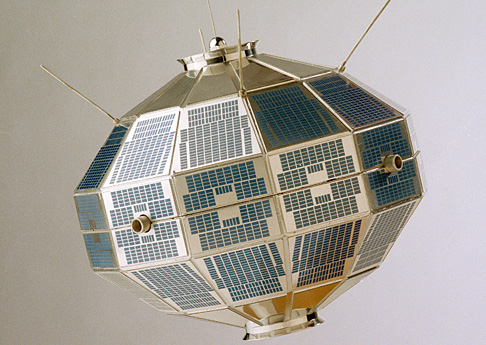 (Photo courtesy of Communications Research Centre Canada and the Canadian Space Agency)
(Photo courtesy of Communications Research Centre Canada and the Canadian Space Agency)
(RCI) September 29th, marks the 50th anniversary of an important milestone in space. On this date in 1962, Canada became the third nation in the world, after the U.S. and Russia, to have designed and built its own earth orbiting satellite. This was only five years after the shocking news that Russia had put Sputnik into space.
The mission of Alouette-1 was to study the ionosphere, and although originally designed to operate for one year, was in fact operational for ten years before being switched off. The satellite is still orbiting, and some think it would still switch back on if the right signals were sent.
Alouette anniversary — Celebrating 50 years of Canada’s role in space
By Hillary Windsor
(Canadian Geographic Magazine) Fifty years ago this autumn, after many small steps, Canada took one giant leap into the future.
The successful launch of the Alouette-I satellite on September 29, 1962, made Canada the third nation (after Russia and the United States) to design and build its own satellite and signalled to the world that our country was going to be a player in the space age.
But it wasn’t all smooth sailing straight into the stratosphere for the Ottawabased research and design team, led by the late John Chapman under the auspices of Canada’s Defence Research Telecommunications Establishment (later to become Communications Research Centre Canada). Although the team had world-class engineers and scientists working on the project and believed it would succeed, others weren’t so sure.
… In 1987, Communications Research Centre Canada designated the Alouette-I as one of the 10 most outstanding achievements in the first 100 years of engineering in Canada — a notable tip of the hat that put the satellite in the same company as CPR’s transcontinental railway network, the St. Lawrence Seaway and the CANDU nuclear power system.
25 September
Canadian to command the International Space Station
(RCI) Canadian astronaut Chris Hadfield has established a number of firsts, including being the first Canadian to walk in space, the only Canadian to board the MIR space station, and soon, the first Canadian to command the International Space Station (ISS) on what’s called Expedition 34/35
He is set to blast off aboard a Soyuz rocket on December 19th, from the Baikonur base in Kazakhstan.
24 September
Space Shuttle Endeavour’s Final Flight as Seen From Space
(Wired.com|Science) The Space Shuttle Endeavour’s final flight last week was likely one of the most photographed plane flights in history. Riding piggyback on a specially adapted Boeing 747, Endeavour’s farewell tour took it from Kennedy Space Center in Florida to Los Angeles International Airport, cruising over cities including New Orleans, Houston and San Francisco along the way, creating photo ops everywhere it went for professionals and amateurs alike.
21 September
Thrilled Los Angeles Museum Welcomes Space Shuttle Endeavour
(Yahoo!News) LOS ANGELES — The space shuttle Endeavour has landed for the final time, and its new owners can hardly believe that the historic vehicle is now in their hands.
Endeavour, flying piggyback atop its Boeing 747 carrier aircraft, touched down here at Los Angeles International Airport today (Sept. 21) to wrap up a nationwide farewell tour. The shuttle will stay at the airport for a few weeks, and then be ferried via surface streets to its museum retirement home, the California Science Center, in mid-October.
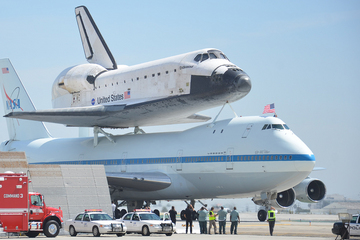 Space shuttle Endeavour to final frontier, in Los Angeles
Space shuttle Endeavour to final frontier, in Los Angeles
(Reuters) – The space shuttle Endeavour, bolted to the top of a jumbo jet, was to take off on Friday from Edwards Air Force Base for a last airborne victory lap over California en route to its final frontier and retirement home – a science museum in Los Angeles.
Riding piggyback on a specially modified Boeing 747, the 75-ton winged spaceship was scheduled to depart at 8:15 a.m. Pacific time (1515 GMT) on the final leg of its cross-country trip that started on Wednesday in Cape Canaveral, Florida. The scheduled departure was about an hour later than originally planned due to fog over the San Francisco Bay area.
After making at least 20 planned low-altitude passes over some of California’s best-known landmarks and scientific institutions, including Disneyland and the Jet Propulsion Laboratory, Endeavour and its carrier jet are expected to land at Los Angeles International Airport at about 12:45 p.m. local time (1945 GMT).
25 August
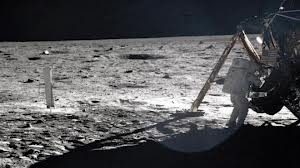 First man on moon Neil Armstrong dead at 82
First man on moon Neil Armstrong dead at 82
(Reuters) – U.S. astronaut Neil Armstrong, who took a giant leap for mankind when he became the first person to walk on the moon, has died at the age of 82, his family said on Saturday.
His family expressed hope that young people around the world would be inspired by Armstrong’s feat to push boundaries and serve a cause greater than themselves.
Armstrong died following complications from heart-bypass surgery he underwent earlier this month, the family said in a statement, just two days after his birthday on August 5.
As commander of the Apollo 11 mission, Armstrong became the first human to set foot on the moon on July 20, 1969. As he stepped on the dusty surface, Armstrong said: That’s one small step for (a) man, one giant leap for mankind.
Those words endure as one of the best known quotes in the English language.
The Apollo 11 astronauts’ euphoric moonwalk provided Americans with a sense of achievement in the space race with Cold War foe the Soviet Union and while Washington was engaged in a bloody war with the communists in Vietnam.
Neil Alden Armstrong was 38 years old at the time and even though he had fulfilled one of mankind’s age-old quests that placed him at the pinnacle of human achievement, he did not revel in his accomplishment. He even seemed frustrated by the acclaim it brought.
Neil Armstrong, the moon’s mystery man
By Virginia Heffernan
(Yahoo! News) … Though astronauts in the time were represented as hard-partying matinee idols, Armstrong always described himself as a “white-socks, pocket-protector, nerdy engineer.” He wasn’t boasting, though engineers are, of course, the hotshots of today: the hackers and technologists who keep pushing into the new breach—the postfinal frontiers of cyberspace.
Once in 1969, Norman Mailer bullied Armstrong into saying something—anything—romantic about going to the moon. (Armstrong would have to cough up the romance, Mailer wrote, or be considered “a spiritual neuter.”) Armstrong stood his ground like a Buddha. “I think we’re going to the moon because it’s in the nature of the human being to face challenges,” he said, defying Mailer. “It’s by the nature of his deep inner soul … We’re required to do these things just as salmon swim upstream.”
Those words are perhaps the most gorgeous words the press-shy astronaut ever said, including his famous scripted line about the giant leap.
Michael Collins, an Apollo 11 crewmate, wrote that Armstrong “never transmits anything but the surface layer, and that only sparingly … I like him, but I don’t know what to make of him, or how to get to know him better.”
Maybe we weren’t meant to fully understand Armstrong. Only to hold him in awe. Like the moon itself.
Cronkite Anchors First Moonwalk
23 August
Neutrinos and solar storms — And now, the space-weather forecast
(The Economist) Solar flares, in which charged particles are ejected from the sun, can damage satellites and ground-based electronic infrastructure. In 2005 an unseasonal solar storm knocked out a number of Global Positioning System (GPS) birds, some of them for good. It also forced airliners to be redirected from Arctic routes, where Earth’s magnetic field provides least cover from the nefarious effects a hail of such particles can have on the people’s, and machines’, health. And that was a mere breeze compared with the solar storm of 1859, thought to have been many times more devastating on the basis of the disruption it caused to the nascent telegraph service. These days, another Carrington Event, as the 19th-century episode is known, risks crippling a planet increasingly reliant on all sorts of electronic gubbins.
A number of advance-warning systems, enabling countermeasures such as temporary shutdown of vulnerable electronics, are in the works. But reliable forecasts are scarce. This is because solar storms are not yet well understood. Paradoxically, Dr Jenkins and Dr Fischbach think this might change with the help of neutrinos, the ethereal particles which pervade the universe but rarely interact with anything—and themselves a cause of much head-scratching among physicists.
29 July
The ISS gets an aquarium
(GizMag) The International Space Station (ISS) is a little homier now thanks to its new aquarium. This addition isn’t just intended to brighten up the lunch room – it’s a serious piece of experimental hardware built by the Japanese Space Agency (JAXA) and delivered the the ISS on Friday, July 27, 2012 by the unmanned Japanese cargo ship, Kounotori3 (HTV3). The special aqueous habitat will be used to study the effects of the space environment on marine life.
27 July
How NASA launched the 2012 Olympics — 12 years ago
The only problem was, pins that were aboard shuttle on flight said it would be in Houston
(MSNBC) As Atlantis orbited high above the Earth, Houston was in the running to be the U.S. Olympic Committee’s bid city to host the 2012 Summer Olympics, competing against New York, San Francisco, and Washington, D.C.-Baltimore. … NASA, in support of bringing the Olympics to Houston — home of Mission Control and the U.S. astronaut corps — launched aboard Atlantis 1,000 lapel pins for the Houston 2012 Foundation. The organization described its role as “to identify, package and communicate the reasons why Houston is the best place for the 2012 Olympic Games.”
26 July
Humongous telescope coming with Canada’s help
(RCI) A joint project of NASA, The Canadian Space Agency and the European Space Agency, the James Webb Space Telescope will be launched in 2018.
Where the Hubble telescope is the size of a school bus, the JWST will be the size of a tennis court. It is so big that it will be folded up like a big origami for launch. It will have a huge mirror: 6.6 meters and will hide in the shadow of the earth so no light will interfere with its infrared equipment.
“It will study every phase in the history of our Universe,” says the NASA news release, “ranging from the first luminous glows after the Big Bang, to the formation of solar systems capable of supporting life, to the evolution of our own Solar System.”
17 April
Space shuttle Discovery makes final flight to museum
(Reuters) – The space shuttle Discovery made its final voyage on Tuesday: a piggyback jet ride to the Smithsonian National Air and Space Museum annex in Virginia.
The United States retired its space shuttles last year after finishing construction of the $100 billion International Space Station, a project of 15 countries, to begin work on a new generation of spaceships that can carry astronauts to destinations beyond the station’s 240-mile-high (384-km-high) orbit.
17 February
Cleaning Up the Cosmos Swiss Develop Satellite to Dispose of Space Junk
(Spiegel) Scientists warn that the amount of space debris orbiting the planet has reached a dangerously high level. But a new miniature satellite has been designed to clean up this cosmic clutter — by the paragons of tidiness themselves, the Swiss.
2011
26 November
NASA rover launched to seek out life clues on Mars
(Reuters) – An unmanned Atlas 5 rocket blasted off from Florida on Saturday, launching a $2.5 billion nuclear-powered NASA rover toward Mars to look for clues on what could sustain life on the Red Planet.
It soared through partly cloudy skies into space, carrying NASA’s Mars Science Laboratory on a 354-million mile (556 million km), nearly nine-month journey to the planet.
The car-sized rover, nicknamed Curiosity, is expected to touch down on August 6, 2012, to begin two years of detailed analysis of a 96-mile (154-km) wide impact basin near the Martian equator called Gale Crater.
The goal is to determine if Mars has or ever had environments to support life.
21 July
Atlantis has landed, ending NASA’s shuttle era
(Reuters) – The space shuttle Atlantis returned from NASA’s final shuttle mission on Thursday, ending a 30-year era that opened the space frontier, exposed its dangers and established a toehold for future endeavors beyond Earth.
Atlantis’ landing capped a three-decade program that made spaceflight appear routine, despite two accidents that killed 14 astronauts and destroyed two of NASA’s five spaceships.
The last accident investigation board recommended the shuttles be retired after construction was finished on the space station, a $100 billion project of 16 nations. That milestone was reached this year, leaving the orbiting research station as the shuttle program’s crowning legacy.
Details of a follow-on program are still pending but the objective is to build new spaceships that can travel beyond the station’s near-Earth orbit and send astronauts to the moon, asteroids and other destinations in deep space.
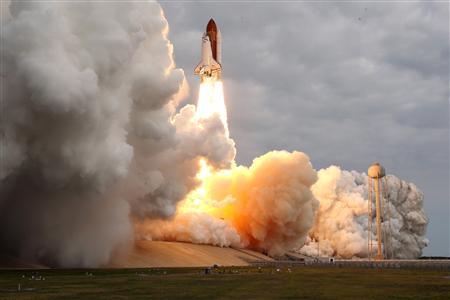
16 May
Endeavour soars off on second-to-last shuttle flight
(Reuters) – U.S. space shuttle Endeavour blasted off on Monday on the next-to-last flight in NASA’s shuttle program, carrying a potentially revolutionary physics experiment to the International Space Station.
The flight is the 25th and final one for the spacecraft Endeavour, which was expected to reach the orbital outpost on Wednesday. NASA plans one more mission to the station, using the sister shuttle Atlantis, in July, before ending the shuttle program.
14 May
Canadarm builder set to tackle next frontier in space technology
(Global News) MacDonald Dettwiler and Associates, based in Richmond, B.C., is in the early stages of a project that would expand Canada’s reputation as an international leader in space technology.
MDA recently announced a $280-million U.S. deal with world-leading satellite service provider Intelsat to build, launch and operate a remote-controlled vessel that will be, in effect, a mobile service station in space.
9 May
Op-Ed: America quits race for space
(Digital Journal) It’s official. America has left the space race. Once Endeavour is cleared for launch and its mission completed NASA’s shuttle program will be over.
The Allen Telescope Array, run by the SETI Institute near Mt. Shasta, has had its funding cut, leaving the project shutdown with its array of radio telescopes turned off, deaf, and pointing towards the ground. Last month, the project ran out of funding, another victim of shrinking grants and the current financial climate that pervades the country.
28 April
Original Canadarm makes its last space flight Friday before coming back home
(CP) The original Canadarm, which flexed its robotic muscles for the first time almost 30 years ago, is making its last trip into space on Friday before coming home.
The giant arm, which cost $108 million to develop from scratch, will be on board Endeavour when the U.S. space shuttle makes its final flight to the International Space Station.
… before Endeavour becomes a museum piece, the iconic Canadarm, with serial number 201, will be removed for shipment back to Canada.
Canada’s first robotic space arm will have travelled more than 144 million kilometres when its 27th and final space mission ends with Endeavour’s return.
12 April
Endeavour’s Canadarm coming home
Museums vie for robotic arm from space shuttle
(CBC) The Canadian robotic arm on one of NASA’s space shuttles is heading back north after the shuttles retire, CBC News has learned.
Each of NASA’s three shuttles is equipped with a Canadarm, designed and built in Canada. After the shuttle program ends with the final flight of Atlantis in June, NASA plans to keep the robotic arms on Discovery and Atlantis for itself, but the Canadarm on the Endeavour has been earmarked for Canada.
Canadian science museums are already making the case for why their particular facility is the optimal one for displaying the arm.
CBC Archives: Canadarm – A Technology Star
2010
16 April
NEW SPACE OPPORTUNITIES SEEN FOR CANADA
(RCI) The head of the Canadian Space Agency, Steve MacLean, says there will be new opportunities for Canada as the United States space agency NASA prepares for new programs. Mr. Maclean, a former astronaut, says Canada can contribute key technology to NASA. He also says NASA’s new direction will open up opportunities for small and medium-sized enterprises for Canadian companies. U.S. President Barack Obama recently announced plans to send astronauts to an asteroid and then onto Mars within his lifetime. He’s also boosting NASA’s budget by $6 billion over five years.
NASA’s robotic jet begins science expedition
One of NASA’s newest research jets soared high over the Pacific Ocean on Tuesday on a 24-hour mission to study Earth’s atmosphere. Its pilot remained seated in an office chair in a windowless room in the Mojave Desert, monitoring the autonomous flight of the Global Hawk via an array of computer screens. NASA has begun putting [the Global Hawk] to work for the first time with flights over vast areas of the Pacific to demonstrate the scientific usefulness of the unmanned aircraft.
13 April
Obama to Propose $6 Billion NASA Budget Increase
(Reuters) – President Barack Obama will outline a revamped space policy on Thursday that will use $6 billion in new funding over five years to create 2,500 new jobs in Florida with the ultimate goal of going to Mars.
5 April
Discovery lifts off in one of NASA’s final orbiter missions
(LA Times) The shuttle flight, the last to have a crew of seven, takes equipment and supplies to the International Space Station. Three launches remain before the fleet is retired.
3 February
Space to thrive – A plan to overhaul America’s space agency is long overdue
The rethink looks at four areas: new ways of getting into space; extending the life and use of the space station; the agency’s relationship with the private sector; and its scientific mission.
2 February
Canadian aerospace industry says Obama budget presents a great opportunity
(CP) NASA administrator Charlie Bolden foresees more participation by the commercial space flight industry and a partnership approach involving the United States and its international partners. NASA will also extend the life of the International Space Station until 2020.
Claude Lajeunesse, the CEO of the Aerospace Industries Association of Canada, says the Obama budget focuses on areas like robotics development where Canada is very strong. But Lajeunesse again called on the Harper government to adopt and support a clear long-term space plan. Former astronaut Marc Garneau says Canada’s long-term space plan has been sitting in Industry Minister Tony Clement’s office since last fall.
Obama budget proposal scraps NASA’s back-to-the-moon program
The Obama administration is killing Constellation, NASA’s ambitious back-to-the moon program. The decision represents a thunderous demolition of the Bush-era strategy at the space agency, which had already poured $9 billion into a new rocket, the Ares 1, and a new crew capsule, Orion.
2009
5 October
Garneau marks 25 years of Canadians in space
Exactly 25 years after Canada’s first astronaut captured this country’s imagination by blasting into space, the country celebrates another extraterrestrial milestone this week with a unique spectacle planned by Canada’s first space tourist.
Marc Garneau wound up on cereal boxes and had schools named for him after Oct. 5, 1984, when the young naval officer began an eight-day mission on the now-infamous space shuttle Challenger.
Space tourist Guy Laliberté sends water-conservation message to Earth
MONTREAL — Every time a wasted drop of water hits the sink, Guy Laliberte wants you to know it could go to better use.
The Quebec City-born Laliberté, Canada’s first space tourist and founder of Cirque du Soleil, is on a quest to raise awareness about water use. Canada has 20 per cent of the world’s fresh water and less than half of one per cent of the world’s population.
Events mark 25th anniversary of first Canadian in space
Canada is marking a milestone: Marc Garneau blasted into space as the country’s first astronaut 25 years ago Monday.
The anniversary coincides with another first – Guy Laliberte as Canada’s first space tourist. The Quebec billionaire paid $35 million to spend nine days on the International Space Station. He is also visiting Canadian astronaut Bob Thirsk whose six-month stay on the giant space lab ends Nov. 23. Garneau, now a Montreal Liberal MP, said he could never have anticipated how far space tourism or co-operation with the Russians would have come in just 25 years.
Members of Parliament held a surprise reception for the astronaut-turned-politician Monday night, a celebration that made Garneau tear up as he recalled the wonder and fear of his first spaceflight.
30 September
Adventure and risk are not alien to space tourist Guy Laliberté
Laliberte, a Russian cosmonaut and an American astronaut blasted off into space early Wednesday aboard a Soyuz spacecraft headed for the International Space Station. Laliberté’s stint as Canada’s first space tourist on the space station will be just the latest milestone in a life where adventure has been anything but alien.
The Eagle Has Landed
Jul 26th 1969
From The Economist print edition
They’re down; they’re safe; they’ve shown it can be done. The Eagle has landed. There is life on the moon, at last. And space itself seems friendlier. The men who have been out there before—after nine years there are still only 37 of them, plus one woman—have been near-robots, bulky servo-mechanisms slotted into their capsule’s machinery. Yet man frisking on the powdery moon is different. Preposterously space-suited, sweating heavily and near middle-aged he may be, but he is no robot.
At every bounding step, by Armstrong and Aldrin, the moon seemed almost to accommodate itself to man. It is not a particularly comfortable place, but it neither impeded the astronauts’ landing, nor their departure on the journey back to earth. Dust on its surface did not stick excessively to their feet, their cameras or their windows. The physical toll on them was less than half what had been expected; the visitors did not come anywhere near using up their oxygen and water reserves. The scientific equipment they had brought could be erected and worked; there were interesting, purple rocks to take back to scientific earthmen. Courage of a cold and disciplined kind that few men have ever been called upon to show was rewarded by proof positive of what we could only suspect a week ago: that man, from this day on, can go wheresoever in the universe his mind wills and his ingenuity contrives.
20 July 2009
Apollo astronauts bemoan state of U.S. space program
CAPE CANAVERAL, Florida (Reuters) – The U.S. investment in the Apollo space program, which landed men on the moon, paid off handsomely, unlike the $100 billion plowed into the International Space Station, Apollo’s pioneering astronauts said on Monday.
What’s lacking, the astronauts say, is an inspiring goal, a motivating force, such as what the objective of landing on the moon did for the Apollo initiative. “To me, exploration is going someplace that you haven’t been before,” said Aldrin, who would like to see NASA move on to Mars, rather than leading a return to the moon. The current plan, developed in the wake of the 2003 Columbia accident, is for NASA to complete the space station, return astronauts to the moon and eventually move on to Mars and other destinations in the solar system.
20 July
From Earth to the moon
The first step on the moon was a historic achievement for the United States and the world. But the crucial Canadian contributions were more than just a footnote
(Globe & Mail) During the early days of the U.S. space program, a team of engineers north of the American border – including [ Owen] Maynard – were at work on the design and construction of the Avro Arrow, a sophisticated interceptor jet fighter. When the federal government axed the program in 1959, Robert Gilruth, a pioneer of the American space program who later became the director of the Manned Spacecraft Center, flew to Toronto the next day. By the day’s end, he had hired 25 men to join him in Virginia. Seven more from the Canadian company joined his team soon after.
After Mr. Maynard transplanted his family to Virginia (and later to Houston), there was little time to adjust. In 1961, President John F. Kennedy announced the goal to send a man to the moon by the end of the decade. The pressure was on.
Mr. Maynard, with a decade of jet engineering experience under his belt, was hired as chief of systems engineering. [He was] the man who designed the lunar module “Eagle” that astronaut Buzz Aldrin piloted.
18 July
NASA Sets Its Sights On Return To Moon, Then On To Mars
As it prepares to commemorate the 40th anniversary of the first manned moon landing on July 20, the U.S. space agency NASA is looking to build on its achievements by establishing a permanent station on the moon’s surface as it maps a path for space exploration to Mars and beyond.
Great strides have been made in understanding the lunar environment in the 40 years since U.S. astronauts Neil Armstrong and Buzz Aldrin became the first people to walk on the moon.
Robotic missions have identified evidence of ice at the moon’s poles, a potential source of water that could open the way for the establishment of a permanent lunar base and make exploration further into the solar system easier to conduct.
(AP/Chicago Sun-Times ) — A NASA spaceship has taken the first-ever photos from space showing equipment left behind when man went to the moon. The images released Friday are from the Lunar Reconnaissance Orbiter, which was launched last month. They show the landing sites from Apollo 11, which landed 40 years ago on Monday, and four other Apollo missions. On the Apollo 11 landing site, there’s a fuzzy image near a crater. That’s the Eagle lunar module, which took Neil Armstrong and Buzz Aldrin to the moon. The images for Apollo 14 are the best so far. They show the tracks made by astronauts Alan Shepard Jr. and Edgar Mitchell.
17 July
Conspiracy Theorists: Apollo Moon Landing Hoax Proof, NASA Video Tapes Erased!
Capricorn One, The Sequel
(Information Week) Already, conspiracy theorists have challenged the far better footage from subsequent missions: astronaut movement proves that they’re being dangled by wires, and not enjoying the Moon’s low gravity; the flag planted on the surface waves when there’s no air to move it; background stars are missing, and the shadows are all wrong; spotlights and a soda pop bottle have been sighted. The fundamental suspicion is that the entire shebang was faked, a la the mission to Mars in the 1978 movie “Capricorn One.”
16 July
Moon landing tapes got erased, NASA admits
(Reuters) The original recordings of the first humans landing on the moon 40 years ago were erased and re-used, but newly restored copies of the original broadcast look even better, NASA officials said on Thursday.
15 July
Shuttle launches carrying Canadian Payette
(CBC) NASA engineers evaluating video of debris hitting shuttle’s heat shield
Endeavour’s seven astronauts, including Payette, are scheduled to perform five spacewalks and complete the construction of the Japan Aerospace Exploration Agency’s Kibo experiment module at the space station during their 16-day mission. Payette, the flight engineer, will operate the shuttle’s Canadarm 1, the space station’s Canadarm 2 and a third mechanical arm that is to be installed on Kibo.
